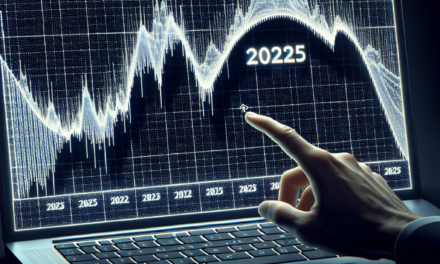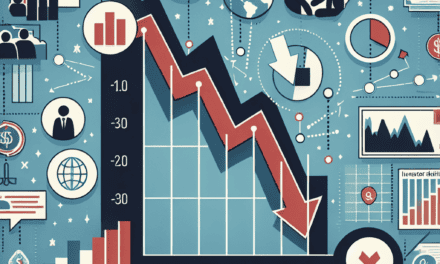“Dollar Strengthens Amid Fed Rate Cut Controversy: Stability in Uncertain Times.”
Introduction
The recent strengthening of the U.S. dollar has become a focal point in financial markets as the Federal Reserve’s potential rate cuts come under increasing scrutiny. As investors weigh the implications of a shifting monetary policy landscape, the dollar’s resilience reflects a complex interplay of economic indicators, geopolitical tensions, and market sentiment. With inflationary pressures and labor market dynamics influencing the Fed’s decision-making, the dollar’s performance is closely tied to expectations surrounding interest rates. This scenario raises critical questions about the sustainability of the dollar’s strength amid evolving economic conditions and the Fed’s response to emerging challenges.
Dollar Strength and Economic Implications
The recent strengthening of the U.S. dollar has sparked considerable discussion among economists and market analysts, particularly in light of the Federal Reserve’s monetary policy decisions. As the Fed contemplates potential rate cuts, the implications for the dollar’s value and the broader economy become increasingly significant. A robust dollar can have multifaceted effects, influencing everything from inflation to international trade dynamics.
To begin with, a stronger dollar typically reflects investor confidence in the U.S. economy. When the dollar appreciates, it often indicates that investors are seeking safety in U.S. assets, particularly during periods of global uncertainty. This trend can be attributed to the relative stability of the U.S. financial system compared to other economies. However, while a strong dollar may signal economic strength, it can also pose challenges for domestic manufacturers and exporters. As the dollar rises, U.S. goods become more expensive for foreign buyers, potentially leading to a decrease in export demand. This situation can create a ripple effect, impacting job growth and overall economic performance.
Moreover, the relationship between the dollar’s strength and inflation is complex. A stronger dollar generally exerts downward pressure on inflation by making imported goods cheaper. This dynamic can be beneficial for consumers, as it may lead to lower prices for everyday items. However, the Fed’s focus on maintaining price stability complicates this scenario. If the dollar continues to strengthen, the central bank may face pressure to adjust its interest rate strategy, particularly if inflation remains subdued. In this context, the Fed’s potential rate cuts come under scrutiny, as they could inadvertently contribute to a stronger dollar, further complicating the inflation landscape.
Transitioning to the global stage, the dollar’s strength has significant implications for international trade. Countries that rely heavily on exports may find themselves at a disadvantage as their goods become less competitive in the U.S. market. This situation can lead to trade imbalances and may prompt foreign governments to implement countermeasures, such as currency devaluation or tariffs. Consequently, the interconnectedness of global economies means that fluctuations in the dollar’s value can have far-reaching consequences, affecting not only U.S. trade partners but also the overall stability of the global economy.
Furthermore, the dollar’s status as the world’s primary reserve currency adds another layer of complexity. Many countries hold U.S. dollars as part of their foreign exchange reserves, which can create a feedback loop. As the dollar strengthens, it may encourage more countries to accumulate reserves, further solidifying its dominance. However, this reliance on the dollar also raises concerns about the potential for volatility in global markets. If the Fed’s rate cuts lead to a weakening of the dollar in the long term, it could prompt a reevaluation of currency reserves by other nations, potentially destabilizing the current financial order.
In conclusion, the strengthening of the dollar amid discussions of Federal Reserve rate cuts presents a multifaceted challenge for policymakers and market participants alike. While a robust dollar can signal economic confidence and help keep inflation in check, it also poses risks to exporters and complicates international trade dynamics. As the Fed navigates these complexities, the implications of its monetary policy decisions will continue to reverberate throughout the economy, influencing everything from consumer prices to global trade relationships. The interplay between the dollar’s strength and economic conditions will remain a critical area of focus for analysts and decision-makers in the months ahead.
Fed Rate Cuts: Historical Context and Impact
The Federal Reserve’s decisions regarding interest rates have historically played a pivotal role in shaping the economic landscape of the United States. When the Fed opts to cut rates, it typically aims to stimulate economic growth by making borrowing cheaper, thereby encouraging consumer spending and business investment. However, the implications of such cuts extend beyond immediate economic relief; they can also influence the strength of the U.S. dollar in the global market. Understanding the historical context of Fed rate cuts provides valuable insight into their broader impact on the economy and currency valuation.
Historically, the Fed has employed rate cuts during periods of economic downturn or uncertainty. For instance, during the 2008 financial crisis, the central bank slashed rates to near-zero levels in an effort to revive a faltering economy. This aggressive monetary policy was designed to restore confidence among consumers and businesses, ultimately leading to increased spending and investment. However, while these cuts were effective in stabilizing the economy, they also had significant repercussions for the dollar. As interest rates fell, the attractiveness of holding U.S. assets diminished, leading to a depreciation of the dollar against other currencies.
Moreover, the relationship between Fed rate cuts and the dollar is not merely a matter of immediate economic response; it also reflects broader market perceptions and expectations. When the Fed signals a willingness to cut rates, it can lead to speculation about the future trajectory of monetary policy. Investors often react by reallocating their portfolios, which can result in fluctuations in currency values. For example, if the market anticipates further rate cuts, the dollar may weaken as investors seek higher returns in other currencies. Conversely, if the Fed’s actions are perceived as a sign of economic resilience, the dollar may strengthen, reflecting confidence in the U.S. economy.
In addition to influencing currency values, Fed rate cuts can also have a profound impact on inflation. Lower interest rates tend to increase the money supply, which can lead to higher inflation if not managed carefully. This dynamic is particularly relevant in the current economic climate, where inflationary pressures have become a focal point of concern. As the Fed navigates the delicate balance between stimulating growth and controlling inflation, the implications for the dollar become increasingly complex. A stronger dollar can help mitigate inflation by making imports cheaper, but it can also pose challenges for U.S. exporters, who may find their goods less competitive in foreign markets.
Furthermore, the global interconnectedness of economies means that Fed rate cuts do not occur in isolation. The actions of the Federal Reserve can influence central banks around the world, prompting them to adjust their own monetary policies in response. This interconnectedness can lead to a ripple effect, where changes in U.S. interest rates impact global capital flows and currency valuations. As a result, the strength of the dollar is often viewed as a barometer of global economic health, reflecting not only domestic conditions but also international sentiment.
In conclusion, the historical context of Fed rate cuts reveals a complex interplay between monetary policy, economic growth, inflation, and currency valuation. As the Federal Reserve continues to navigate the challenges of the current economic environment, the scrutiny of its rate-cutting decisions will remain paramount. The strength of the dollar, influenced by these decisions, serves as a critical indicator of both domestic and global economic dynamics, underscoring the far-reaching implications of the Fed’s monetary policy actions.
Global Reactions to a Strengthening Dollar
As the U.S. dollar continues to strengthen, global reactions are becoming increasingly pronounced, reflecting the complex interplay of economic factors and geopolitical dynamics. The dollar’s ascent is largely attributed to the Federal Reserve’s monetary policy, particularly as discussions surrounding potential rate cuts come under scrutiny. This scrutiny has led to a reevaluation of the dollar’s role in international markets, influencing various economies and financial systems worldwide.
In many emerging markets, the strengthening dollar poses significant challenges. As the dollar appreciates, it often leads to a depreciation of local currencies, making it more expensive for these nations to service dollar-denominated debt. Consequently, countries with substantial foreign debt may experience increased financial strain, which can hinder economic growth and stability. For instance, nations in Latin America and parts of Africa are particularly vulnerable, as they rely heavily on exports priced in dollars. A stronger dollar can diminish their competitiveness in global markets, leading to trade imbalances and potential economic downturns.
Moreover, the impact of a strengthening dollar extends beyond emerging markets. In developed economies, particularly those in Europe and Asia, the dollar’s rise can complicate monetary policy decisions. Central banks in these regions may find themselves under pressure to adjust their own interest rates in response to the dollar’s strength. For example, the European Central Bank (ECB) and the Bank of Japan (BoJ) are closely monitoring the situation, as a stronger dollar can lead to capital outflows from their markets, thereby affecting their economic recovery efforts. This dynamic creates a delicate balancing act for policymakers, who must navigate the implications of a strong dollar while striving to maintain economic stability.
In addition to economic ramifications, the strengthening dollar also has geopolitical implications. Countries that are heavily reliant on exports to the United States may find their trade relationships strained as the dollar’s strength alters the competitive landscape. For instance, nations in Asia that export goods to the U.S. may face challenges as their products become relatively more expensive for American consumers. This shift can lead to a reevaluation of trade agreements and partnerships, as countries seek to mitigate the adverse effects of a strong dollar on their economies.
Furthermore, the dollar’s strength can influence global investment flows. Investors often flock to the dollar during times of uncertainty, viewing it as a safe haven. This trend can exacerbate volatility in other currencies and financial markets, as capital shifts toward dollar-denominated assets. Consequently, countries with weaker currencies may experience increased volatility, which can deter foreign investment and hinder economic growth. The interconnectedness of global financial markets means that the effects of a strengthening dollar are felt far and wide, prompting countries to reassess their economic strategies.
In conclusion, the strengthening of the dollar is eliciting a multifaceted response from the global community. Emerging markets are grappling with the challenges posed by a stronger dollar, while developed economies are reassessing their monetary policies in light of its implications. Additionally, geopolitical dynamics are shifting as trade relationships are reevaluated and investment flows are redirected. As the Federal Reserve’s rate cut discussions continue to unfold, the global economic landscape will likely remain in flux, with the dollar’s strength serving as a pivotal factor in shaping future economic interactions and policies.
Inflation Trends Amidst Fed Rate Adjustments
As the Federal Reserve navigates the complexities of monetary policy, the interplay between inflation trends and interest rate adjustments has become increasingly scrutinized. In recent months, the U.S. dollar has demonstrated notable strength, a phenomenon that can be attributed to various factors, including the Fed’s approach to managing inflation. The central bank’s decisions regarding interest rates are pivotal, as they directly influence economic activity, consumer spending, and ultimately, inflation rates.
Inflation, defined as the rate at which the general level of prices for goods and services rises, erodes purchasing power and can significantly impact economic stability. In the wake of the pandemic, inflationary pressures surged, prompting the Fed to implement aggressive rate hikes to curb rising prices. However, as inflation rates begin to show signs of moderation, the question arises: are further rate cuts warranted, or should the Fed maintain its current stance? This dilemma is compounded by the fact that while inflation has eased from its peak, it remains above the Fed’s target of 2%, creating a challenging environment for policymakers.
The strength of the dollar is intricately linked to these inflation trends and the Fed’s monetary policy. A robust dollar typically reflects investor confidence in the U.S. economy and its monetary framework. As the Fed contemplates its next moves, the dollar’s performance against other currencies serves as a barometer for market sentiment regarding future interest rate adjustments. When the Fed signals a potential shift towards rate cuts, the dollar may initially weaken as investors anticipate lower yields on dollar-denominated assets. Conversely, if the Fed maintains a hawkish stance, the dollar often strengthens, reflecting a commitment to combating inflation.
Moreover, the global economic landscape plays a crucial role in shaping inflation trends and the Fed’s response. Supply chain disruptions, geopolitical tensions, and fluctuating energy prices contribute to the complexity of inflation dynamics. For instance, rising oil prices can lead to increased transportation costs, which in turn can drive up prices across various sectors. As the Fed assesses these external factors, it must balance the need for economic growth with the imperative to control inflation. This balancing act is further complicated by the potential for lagging effects; decisions made today may not manifest in the economy for months or even years.
In light of these considerations, the Fed’s communication strategy becomes paramount. Clear guidance on its policy intentions can help manage market expectations and mitigate volatility in the dollar’s value. As investors closely monitor inflation indicators and Fed statements, any hint of a shift in policy can lead to significant fluctuations in currency markets. Thus, the Fed’s ability to navigate this landscape with transparency and precision is essential for maintaining both economic stability and investor confidence.
In conclusion, the relationship between inflation trends and Fed rate adjustments is a critical factor influencing the strength of the dollar. As the Fed grapples with the complexities of monetary policy in an evolving economic environment, its decisions will undoubtedly have far-reaching implications. The ongoing scrutiny of rate cuts reflects a broader concern about inflation management and economic growth, underscoring the delicate balance that the Fed must strike. Ultimately, the trajectory of the dollar will continue to serve as a key indicator of market sentiment and the effectiveness of the Fed’s monetary policy in addressing the challenges posed by inflation.
Currency Markets: Navigating Dollar Volatility
In recent weeks, the currency markets have experienced notable fluctuations, particularly concerning the strength of the U.S. dollar. As investors closely monitor the Federal Reserve’s monetary policy, the anticipation surrounding potential rate cuts has intensified. This scrutiny has led to a complex interplay between the dollar’s value and broader economic indicators, creating a landscape of volatility that traders must navigate with caution.
The dollar’s recent strengthening can be attributed to a combination of factors, including robust economic data and shifting expectations regarding the Fed’s interest rate trajectory. As the U.S. economy continues to show resilience, with indicators such as employment figures and consumer spending remaining strong, market participants have begun to reassess their outlook on future rate cuts. This reassessment is crucial, as the Fed’s decisions on interest rates have a direct impact on currency values. When the Fed signals a potential pause or delay in rate cuts, the dollar often benefits, as higher interest rates tend to attract foreign investment, bolstering demand for the currency.
Moreover, the global economic landscape plays a significant role in shaping the dollar’s performance. As other major economies grapple with their own challenges, including inflationary pressures and geopolitical tensions, the dollar has emerged as a safe haven for investors seeking stability. This flight to safety further supports the dollar’s strength, as capital flows into U.S. assets increase. Consequently, the interplay between domestic economic conditions and international developments creates a dynamic environment for currency traders, who must remain vigilant in their assessments.
In addition to these macroeconomic factors, market sentiment also influences the dollar’s trajectory. Traders often react to news and data releases, leading to short-term volatility that can create both opportunities and risks. For instance, unexpected shifts in inflation data or employment reports can prompt rapid adjustments in currency valuations. As such, understanding the nuances of market sentiment is essential for navigating the complexities of dollar volatility.
Furthermore, the role of central banks beyond the Federal Reserve cannot be overlooked. As other central banks, such as the European Central Bank and the Bank of Japan, implement their own monetary policies, the relative strength of their currencies against the dollar becomes a critical consideration. Diverging monetary policies can lead to significant shifts in exchange rates, impacting trade balances and investment flows. Therefore, currency traders must not only focus on U.S. economic indicators but also keep a keen eye on global central bank actions and their implications for the dollar.
As the currency markets continue to evolve, the importance of risk management strategies becomes increasingly apparent. Traders must be prepared for sudden shifts in market sentiment and economic data releases that can lead to heightened volatility. Utilizing tools such as stop-loss orders and diversifying currency exposure can help mitigate potential losses while capitalizing on favorable market conditions.
In conclusion, the strengthening of the dollar amid scrutiny of Fed rate cuts highlights the intricate relationship between monetary policy, economic indicators, and market sentiment. As traders navigate this landscape of volatility, a comprehensive understanding of both domestic and global factors will be essential for making informed decisions. By remaining adaptable and vigilant, market participants can better position themselves to respond to the ever-changing dynamics of the currency markets.
Investment Strategies in a Strong Dollar Environment
As the dollar strengthens amid scrutiny of potential Federal Reserve rate cuts, investors are faced with a unique set of challenges and opportunities. The appreciation of the dollar can significantly impact various asset classes, prompting a reevaluation of investment strategies. In this context, it is essential to understand how a strong dollar influences market dynamics and to adapt investment approaches accordingly.
Firstly, a robust dollar often leads to a decline in commodity prices, as commodities are typically priced in dollars. Consequently, investors may find it prudent to reassess their positions in commodity-related assets. For instance, precious metals like gold and silver tend to lose their allure when the dollar strengthens, as they become more expensive for foreign buyers. Therefore, investors might consider reducing their exposure to these assets or exploring alternative investments that could benefit from a stronger dollar environment.
Moreover, the strength of the dollar can have significant implications for multinational corporations. Companies that derive a substantial portion of their revenue from overseas markets may experience a decline in profits when the dollar appreciates. This is primarily because their foreign earnings, when converted back to dollars, will yield lower returns. As a result, investors should closely monitor the earnings reports of such companies and consider diversifying their portfolios to include firms that are less sensitive to currency fluctuations. Sectors such as technology and domestic-focused industries may present more resilient investment opportunities in this scenario.
In addition to equities, the fixed-income market also warrants attention in a strong dollar environment. Typically, a stronger dollar is associated with rising interest rates, which can lead to a decline in bond prices. Investors may want to consider adjusting their bond portfolios by favoring shorter-duration bonds, which are less sensitive to interest rate changes. Furthermore, exploring opportunities in floating-rate bonds could provide a hedge against rising rates, as these instruments tend to perform better in a tightening monetary policy environment.
Transitioning to international investments, a strong dollar can create both challenges and opportunities. While U.S. investors may find foreign assets more expensive, it is essential to recognize that certain international markets may still offer attractive valuations. Emerging markets, for instance, can present compelling investment opportunities, particularly if they are less reliant on dollar-denominated debt. Investors should conduct thorough research to identify regions and sectors that may benefit from a strong dollar, such as those with robust economic fundamentals or favorable trade balances.
Additionally, currency hedging strategies may become increasingly relevant in a strong dollar environment. Investors who hold foreign assets might consider employing hedging techniques to mitigate potential losses stemming from currency fluctuations. By utilizing options or forward contracts, investors can protect their portfolios from adverse currency movements, thereby enhancing overall returns.
In conclusion, the strengthening of the dollar presents a complex landscape for investors, necessitating a thoughtful approach to investment strategies. By reassessing exposure to commodities, evaluating the impact on multinational corporations, adjusting fixed-income portfolios, exploring international opportunities, and considering currency hedging, investors can navigate this evolving environment more effectively. Ultimately, staying informed and adaptable will be crucial as market conditions continue to shift in response to the Federal Reserve’s monetary policy decisions and broader economic trends.
Future Projections for the Dollar and Fed Policies
As the financial landscape continues to evolve, the future projections for the U.S. dollar and Federal Reserve policies are becoming increasingly intertwined. Recent developments have prompted analysts to reassess their expectations regarding the dollar’s strength, particularly in light of the Federal Reserve’s monetary policy decisions. The dollar has shown resilience, bolstered by a combination of economic indicators and geopolitical factors that have influenced investor sentiment. This resilience is noteworthy, especially as the Fed’s rate cuts come under scrutiny, raising questions about the implications for both domestic and global markets.
In recent months, the Federal Reserve has faced mounting pressure to adjust its interest rate policies in response to fluctuating inflation rates and economic growth. While the central bank has previously signaled a willingness to implement rate cuts to stimulate the economy, the current economic climate has led to a more cautious approach. As inflation remains a concern, the Fed’s decision-making process is becoming increasingly complex. This complexity is reflected in the dollar’s performance, which has benefited from a flight to safety as investors seek stability amid uncertainty.
Moreover, the dollar’s strength is further supported by the relative performance of the U.S. economy compared to its global counterparts. As other central banks grapple with their own economic challenges, the U.S. dollar has emerged as a preferred currency for investors seeking refuge. This trend is likely to continue, particularly if the Fed maintains a more hawkish stance in the face of potential rate cuts. The interplay between the dollar’s value and the Fed’s policies will be crucial in shaping market expectations and influencing capital flows.
Looking ahead, analysts are closely monitoring key economic indicators that could impact the Fed’s policy decisions and, consequently, the dollar’s trajectory. Employment figures, consumer spending, and inflation data will play pivotal roles in determining whether the Fed opts for further rate cuts or takes a more measured approach. If the economic data suggests a robust recovery, the Fed may be less inclined to pursue aggressive rate cuts, which could bolster the dollar’s strength. Conversely, if economic indicators point to a slowdown, the Fed may feel compelled to act, potentially leading to a depreciation of the dollar.
In addition to domestic factors, global geopolitical developments will also influence the dollar’s future. Trade tensions, political instability, and shifts in foreign policy can create volatility in currency markets. As the dollar is often viewed as a safe haven during times of uncertainty, any escalation in geopolitical risks could further enhance its appeal. Investors will need to remain vigilant, as these external factors can have immediate and far-reaching effects on the dollar’s value.
In conclusion, the future projections for the dollar and Federal Reserve policies are inextricably linked, with each influencing the other in a dynamic economic environment. As the Fed navigates the complexities of monetary policy amid evolving economic conditions, the dollar’s strength will likely reflect these decisions. Investors and analysts alike will need to stay attuned to both domestic economic indicators and global developments, as these elements will shape the dollar’s trajectory in the coming months. Ultimately, the interplay between the Fed’s policies and the dollar’s performance will be a critical focal point for market participants as they seek to understand the broader implications for the economy.
Q&A
1. **Question:** What is the current trend of the U.S. dollar in relation to the Federal Reserve’s interest rate cuts?
**Answer:** The U.S. dollar has strengthened as the Federal Reserve’s rate cuts come under scrutiny.
2. **Question:** Why are the Fed’s rate cuts being scrutinized?
**Answer:** The rate cuts are being scrutinized due to concerns about inflation and the potential impact on economic growth.
3. **Question:** How does a stronger dollar affect U.S. exports?
**Answer:** A stronger dollar makes U.S. exports more expensive for foreign buyers, potentially reducing demand.
4. **Question:** What impact do Fed rate cuts have on investor sentiment towards the dollar?
**Answer:** Fed rate cuts can lead to uncertainty, but if the dollar strengthens, it may indicate confidence in the U.S. economy despite the cuts.
5. **Question:** How do interest rates influence currency strength?
**Answer:** Higher interest rates typically attract foreign investment, increasing demand for the currency and strengthening it, while lower rates can weaken it.
6. **Question:** What are the potential long-term effects of a strong dollar on the U.S. economy?
**Answer:** A strong dollar can lead to trade imbalances, hurt manufacturing competitiveness, and impact corporate earnings negatively.
7. **Question:** What factors, besides Fed rate cuts, can influence the strength of the dollar?
**Answer:** Factors include economic data releases, geopolitical events, inflation rates, and monetary policy decisions from other central banks.
Conclusion
The strengthening of the dollar amid scrutiny of potential Federal Reserve rate cuts indicates a complex interplay between monetary policy expectations and market reactions. As investors reassess the implications of rate adjustments, the dollar’s resilience suggests confidence in the U.S. economy’s fundamentals, despite concerns over inflation and growth. This dynamic highlights the importance of the Fed’s communication and decision-making in shaping market perceptions and currency valuations. Ultimately, the dollar’s strength reflects both immediate market sentiment and broader economic indicators, underscoring the critical role of the Fed in influencing financial stability.





